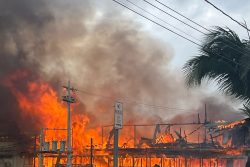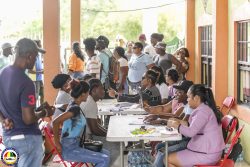The Guyana Human Rights Association (GHRA) said yesterday that the furore surrounding the statement issued by some Amerindian leaders on land rights is “misplaced and unhelpful”.
It said nothing in either statement issued by the leaders or later by the Amerindian Peoples Association (APA) suggests lack of support or even criticism of the Low Carbon Development Strategy or REDD+ strategies.
Following a week-long conference organised by the APA last week, some leaders said that LCDS outreach activities done last year lacked prior information, were often rushed and only lasted a few hours, while suffering from weak or non-existent translation support for communities. They also urged government and international agencies to put a hold on the implementation of policies related to projects like the LCDS and REDD+, until land rights issues are settled and asked that the principle of free, prior and informed consent (FPIC) be respected. The statement by the leaders triggered a strong response by government and Minister of Amerindian Affairs Pauline Sukhai accused the APA of communicating “misconceptions and half-truths.”
In a statement, the Executive Council of the GHRA questioned what is new or controversial about the calls. It said that “those who can remember life before REDD+” would recall that the issue of land rights is the most predictable response from the Amerindian community to any significant development impacting on the hinterland of Guyana. In this light the GHPA pointed out that there were such responses in the 1990s provoked by Asian forestry companies, the development of National Protected Areas and mining permits regularly provoke such a response. “For this reason, it was more than predictable – and legitimate –” that far-reaching proposals such as the LCDS and REDD+, despite their great potential benefits, would trigger land rights concerns,” said the human rights body.
The GHRA said the response of “parading” how much has been done ‘for’ Amerindians can never resolve the land matter. It is instructive, the organisation said, that issues such as forestry, mining and pollution which began as indigenous concerns evolved into national patrimony issues. According to the GHRA, rather than relief that the call has come in such measured and thoughtful terms, LCDS proponents are reacting with a degree of arrogance “which leaves the on-looker uncomfortable”. Said the GHRA: “The conference statement is being derided because the media reports of the conference (SN in particular) focus almost exclusively on the references in the press release to LCDS/REDD+”. It noted that the original conference release was signed by 26 leaders from across the interior including eight toshaos.
The GHRA said that supporters of the policy should recognise that the threat to land rights – not necessarily from REDD+ – is real and affects all Guyanese. It cited an article in this month’s issue of Grain magazine about land grabbing in Latin America.
GHRA said that in their concerns about land titles, Amerindians are demonstrating a greater awareness of “what may be down the road for the rest of the Guyanese community”.
Another statement by the APA had later said that those who attended the conference were “harassed” and the GHRA said yesterday that this is unacceptable. Such behaviour should be noted by the LCDS process monitors, the human rights organisation said. Noting that both statements make frequent reference to FPIC as the guiding principle for any engagement between indigenous communities and the government, the GHRA said that the authorities and proponents would do well to take the phrase seriously and negotiate with Amerindian communities respectfully. “Society as a whole should also be well-advised to cultivate the practice of demanding free, informed and prior consent as a routine matter, not only in relation to REDD+,” the GHRA said.







